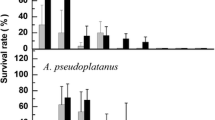Summary
Carrot (Daucus carota) somatic embryos that were treated with abscisic acid during their development have been shown to acquire complete desiccation tolerance when slowly dried, but fail to do so when rapidly dried. We studied plasma membrane permeability by a spin probe technique. On rehydration, the plasma membranes of rapidly dried somatic embryos became permanently leaky, whereas those of slowly dried embryos retained permeability levels as low as for fresh embryos. The leakage was associated with extensive deesterification of the phospholipids. Using low-temperature scanning electron microscopy (LTSEM), we examined (re)hydrated and dry somatic and zygotic embryos. No differences in surface morphology were detected between dry tolerant and intolerant somatic embryos that were obtained by slow and rapid drying, respectively. However, on rehydration, the nonviable somatic embryos had lost turgor and intracellular organization, as revealed by LTSEM images of fractured embryos, whereas the viable somatic embryos had turgescent cells with intact cell structure. In 3-day-imbibed, viable embryos, cell extension was visible. These findings are consistent with the electron paramagnetic resonance data. Somatic embryos always had reduced and abnormal cotyledons, mostly fused, and the surface was irregular. The surface of dry somatic embryo cells was considerably more wrinkled than that of dry zygotic embryo cells. Maturation in polyethylene glycol-containing medium increased the percent dry matter in the fresh somatic embryos and reduced the extent of wrinkling after drying. Wrinkling of the dried embryo cells apparently depends on the filling with dry matter in the hydrated state. We suggest that wrinkling per se does not limit desiccation tolerance of somatic embryos.
Similar content being viewed by others
Abbreviations
- ABA:
-
abscisic acid
- 2,4-D:
-
2,4-dichlorophenoxyacetic acid
- EPR:
-
electron paramagnetic resonance
- LTSEM:
-
low-temperature scanning electron microscopy
- PEG:
-
polyethylene glycol
- SEM:
-
scanning electron microscopy
References
Attree SM, Moore D, Sawhney VK, Fowke LC (1991) Enhanced maturation and desiccation tolerance of white spruce (Picea glauca [Moench] Voss.) somatic embryos: effects of a non-plasmolysing water stress and abscisic acid. Ann Bot 68: 519–525
—, Pomeroy MK, Fowke LC (1992) Manipulation of conditions of the culture of somatic embryos of white spruce for improved triacylglycerol biosynthesis and desiccation tolerance. Planta 187: 395–404
— — — (1994) Production of vigorous, desiccation tolerant white spruce (Picea glauca [Moench] Voss.) synthetic seeds in a bioreactor. Plant Cell Rep 13: 601–606
Fowke LC, Attree SM, Rennie PJ (1994) Scanning electron microscopy of hydrated and desiccated mature somatic embryos and zygotic embryos of white spruce (Picea glauca [Moench] Voss.). Plant Cell Rep 13: 612–618
Gamborg O, Miller R, Ojima K (1968) Nutrient requirements of suspension cultures of soybean roots cells. Exp Cell Res 50: 151–158
Golovina EA, Tikhonov AN (1994) The structural differences between the embryos of viable and nonviable wheat seeds as studied with the EPR spectroscopy of lipid-soluble spin labels. Biochim Biophys Acta 1190: 385–392
— —, Hoekstra FA (1997a) An electron paramagnetic resonance spin probe study of membrane permeability changes with seed aging. Plant Physiol 114: 383–389
—, Wolkers WF, Hoekstra FA (1997b) Behaviour of membranes and proteins during natural seed ageing. In: Ellis RH, Black M, Murdoch AJ, Hong TD (eds) Basic and applied aspects of seed biology: proceedings of the Fifth International Workshop on Seeds, Reading, 1995. Kluwer, Dordrecht, pp 787–796
Gray D, Steckel JRA (1982) The effect of ripening and drying of carrot seed (Daucus carota) crops on germination. Ann Appl Biol 101: 397–406
Hoekstra FA, Van Roekel T (1988) Desiccation tolerance ofPapaver dubium L. pollen during its development in the anther: possible role of phospholipid composition and sucrose content. Plant Physiol 88: 626–632
Jeffree CE, Read ND (1991) Ambient- and low-temperature scanning electron microscopy of plant and fungi. In: Hall JL, Hawes C (eds) Electron microscopy of plant cells. Academic Press, London, pp 313–413
Skriver K, Mundy J (1990) Gene expression in response to abscisic acid and osmotic stress. Plant Cell 2: 503–512
Tetteroo FAA, Hoekstra FA, Karssen CM (1995) Induction of complete desiccation tolerance in carrot (Daucus carota L.) embryoids. J Plant Physiol 145: 349–356
—, de Bruin AY, Henselmans RNM, Wolkers WF, van Aelst AC, Hoekstra FA (1996) Characterization of membrane damage in desiccation-tolerant and -intolerant carrot somatic embryos. Plant Physiol 111: 403–412
Author information
Authors and Affiliations
Rights and permissions
About this article
Cite this article
Tetteroo, F.A.A., van Aelst, A.C., von Recklinghausen, I.R. et al. Membrane permeability, morphology, and desiccation tolerance ofDaucus carota somatic embryos as influenced by drying rate. Protoplasma 202, 202–212 (1998). https://doi.org/10.1007/BF01282548
Received:
Accepted:
Issue Date:
DOI: https://doi.org/10.1007/BF01282548




